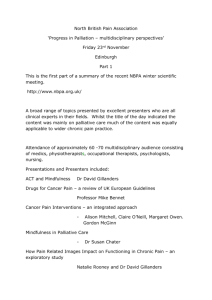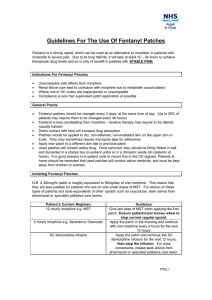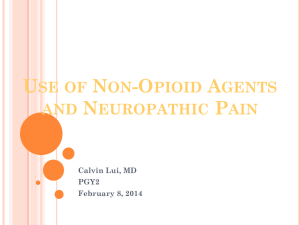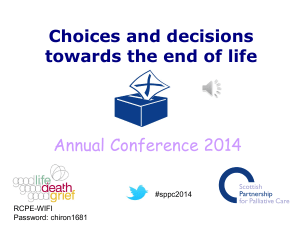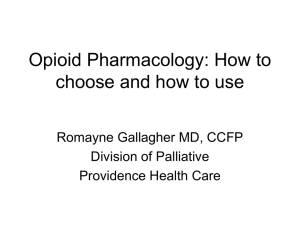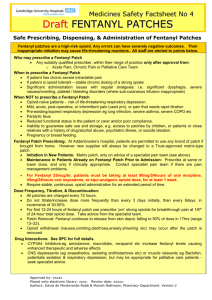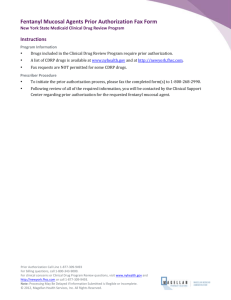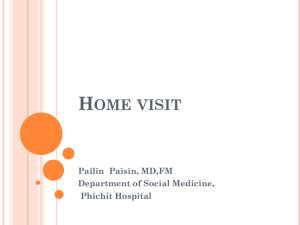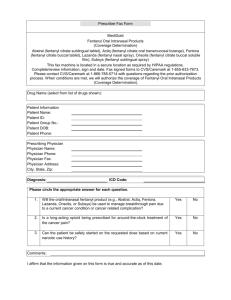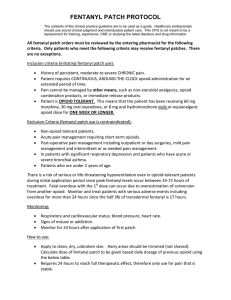Pain Management
advertisement
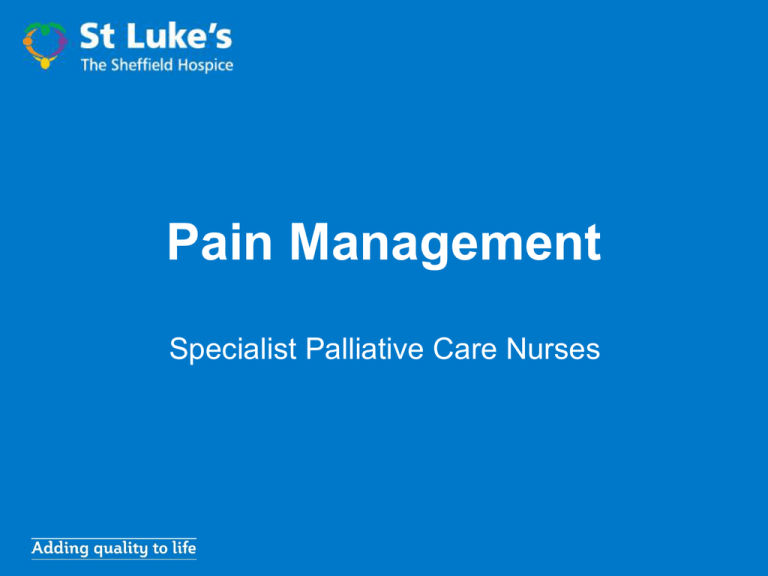
Pain Management Specialist Palliative Care Nurses Learning Outcomes • Define the different types of pain Describe the process of pain assessment • Discuss pharmacological management of pain • Identify non pharmacological approaches for pain management. What is pain? • Pain is an unpleasant sensory and emotional experience associated with actual or potential tissue damage • ‘Pain is whatever the patient says it is and exists whenever he says it does’ • Pain assessment is essential in the management of pain. Total Pain • Physical - pain of the disease process • Psychological/Social –financial/body image/family • Emotional -loss of independence/fear of death • Spiritual –low self esteem /dignity Types of Pain • • • • Soft Tissue Throbbing/tender/ache Oedema Heavy/tight Nerve Throbbing/burning/toothache Raised intracranial pressure Thumping restricting • Bone Gnawing/aching • Colic Cramping/exhausting/gripping Pain Assessment • • • • • • • Location Duration What decreases pain What increases pain Intensity How does the patient respond Pain Tools Pain Assessment Tools • • • • • • • Visual analogue scale Numerical Scale Verbal rating scale McGill pain questionnaire Faces Pain Scale Body Picture Distat Tool Principles in Managing Pain • Right Drug by the Ladder • Right dose by mouth/patch/injection • Right Time by clock WHO Analgesic Ladder Step 3 Morphine 2.5-10 mg 4 hourly oral or other strong opiate (instead of codeine) Step 2 Add codeine 30-60 mg 6 hourly oral or other weak opioid Step 1 Paracetamol 1 g. 6 hourly oral +/- other non-opiate Adjuvant analgesic depending on the mechanism of the pain Specific measures to moderate the cause of the pain – surgery, RT, physiotherapy, nerve blocks, TEN’s, stenting, chemotherapy, hormonal therapy, antibiotics, etc. Emotional, social and spiritual supportive care should be in place. Step 1 Non Opiates +/- Adjuvant • Paracetamol • Aspirin (rarely used in end of life) Step 2 Weak opiates +/- Adjuvant • • • • • • • Co Codamol Codeine Dihydrocodeine Kapake Tramodol Nefopam Buprenorphine patch Step 3 Strong Opiates +/- Adjuvant • • • • • • • • Morphine I/R or S/R Diamorphine I/R Oxycodone I/R or S/R Fentanyl Patch S/R Buprenorphine patch Actiq I/R Methadone I/R but long half life I/R immediate release S/R slow release Adjuvant Analgesics Drug Class Type of Pain Drug names Anticonvulsants Neuropathic Lancinating pain pregabalin, gabapentin, CBZ Antidepressants Neuropathic Burning pain Amitriptyline, nortriptyline, duloxetine Non steroidal antiinflammatories Swelling, bone pain, muscular pain Ibuprofen, diclofenac, naproxen, Muscle relaxants Muscle spasm diazepam, baclofen Steroids Nerve compression, swelling, raised ICP dexamethasone Antispasmodics Colic, smooth muscle spasm Hyoscine Butylbromide`, octreotide, loperamide Bisphosphonates Bone Pain zolendronic acid Anaesthetics Cancer pain, neuropathic pain Nerve blocks, ketamine, intrathecal, lidocaine patches Antibiotics Infection Non Drug Pain Relief • • • • • • • • Heat Cold Relaxation Divisional Therapy Tens Acupuncture Radiotherapy Immobilisation/aids What factors increase or decrease pain? Increase Pain Decrease Pain Insomnia, fatigue Sleep Anxiety, fear Relaxation Depression Elevation of mood Social isolation Companionship, understanding Discomfort Relief of other symptoms Treatment according to pain physiology Noiciceptive Response to Opioid First line Treatment Muscle spasm e.g. cramp No BZD, Baclofen Somatic e.g. Bone pain or Visceral e.g. Liver pain +/- NSAID +/- Opioid Compression – peripheral or Central e.g. SCC +/- Corticosteroid + Opioid Injury – peripheral or CNS e.g. Nerve infiltration +/- TCA +/- antiepileptic (NSAID + Opioid) Neuropathic Drug Treatment • • • • WHO analgesic ladder – stepwise approach Colic – Hyoscine butylbromide, mebeverine Intracranial Pressure/SCC – steroid + analgesics Bone pain – hot/cold packs, analgesics, treat incident pain Drug Treatment • Muscle spasm – Massage/Relaxation, TENs, BZD • Neuropathic Pain – amitriptyline starting from 10mg increasing to 75mg nocte or pregabalin from 25mg increasing to 600mg/day as tolerated, Duloxetine, Nortriptyline, lidocaine patch, clonazepam. Clonazepam • Licensed for epilepsy, myoclonus • Unlicensed- neuropathic pain, restless legs, terminal restlessness • Caution – respiratory disease, renal/hepatic impairment, low dose in elderly • Side Effects / Drug Interactions • Dose 125microgram on – 8mg daily Breakthrough Cancer Pain (BTcP) • Predictable pain e.g. dressing change, movement (walking, coughing) • Unpredictable (spontaneous) pain e.g idiopathic no known cause Treatment of BTcP Correct the correctable Drug Treatment Non-drug Possible Recommended Actions • • • • Advise patient on use of analgesics Advise patient on non-drug treatments Refer for psychological/spiritual support Recommend change in analgesic/ review by medical team Fentanyl • Fentanyl patches (brands: Durogesic D –Trans, Matrifen, Mezolar) matrix or reservoir • Tablets: Sub lingual Abstral, Buccal Effentora • Lozenges: Actiq • Nasal spray: Instanyl, PecFent • Alfentanyl parenteral injections Fentanyl Patches • When patch is initiated it will take 12-18 hours for full absorption. • If converting from SR alternative opiate, commence patch at the same time as last 12 hourly SR tablet is given. • When patch strength is increased it will again need 1218 hours for the medication to reach absorption. • Patient may still require rescue doses of immediate release opiates. • Levels peak at 24-72 hours Risks associated with fentanyl • Fentanyl is a strong opioid and should not be commenced on opioid naïve patients. • It is a slow releasing opioid so there is risk of respiratory depression if not administered correctly. • Direct heat can increase the absorption (heat pads, hot water bottle etc) • Risk of abuse. • If administered by nurses record on a green card • Report incidents to Locality Manager End of Life Scenario • 60 year old lady diagnosed with lung cancer 6 months ago. PMH of ischaemic heart disease. • Lives with husband. • Previous radiotherapy for spinal metastases, no further treatment planned. For palliative care and symptom management. • Back and shoulder pain have been managed fairly well on current medication. Scenario cont: • Over the past few days her general condition has started to deteriorate. • In the last 24 hours condition has deteriorated further with escalating pain across her back and shoulder and increased anxiety, dyspnoea, respiratory secretions and nausea. • She is starting to have difficulty swallowing medication. Taking no diet and very little fluid. • How would you manage her symptoms ? Current medication Fentanyl 75mcg/hr patch Oramorph 45mg prn Pregabalin 200mg bd Haloperidol 1.5mg nocte Lorazepam SL 0.5mg prn Furosemide 40mg daily Omeprazole 20mg daily Bisoprolol 2.5mg daily Sol. Aspirin 75mg daily Conclusion • Pain affects quality of life • Patients have the right to be pain free • Continual and effective assessment is essential for successful pain management • Pharmacological and non pharmacological methods should be used in treatment. • Correct medication for pain type Further information • • • • NICE guidance on opioids for pain in palliative care NICE guidance on neuropathic pain (2010) PCF4 (2012) – www.palliativedrugs.com Clinical Knowledge Summaries http://www.cks.nhs.uk/palliative_cancer_care_pain/mana gement • Sheffield Palliative Care Formulary 3rd Edition
